


xxxxxHaving soundly defeated the Austrians at the Battle of Ulm in October 1805, Napoleon entered Vienna and then marched north into Moravia to take on the Russians and the remnant of the Austrian army. He advanced to Brunn, and in December 1805 found himself facing a combined enemy which outnumbered his own force by over 20,000. Anticipating that the Russian commander would attempt to outflank the French army and cut off its retreat to Vienna, Napoleon stood his ground and prepared counter measures. When his enemy did attack as he had predicted, he intercepted and drove back the flanking movements, and then launched a frontal attack upon the depleted Russian and Austrian forces holding Pratzen Plateau. After fierce fighting the French broke through their lines, and drove them towards the town of Austerlitz, inflicting heavy loses. This stunning victory was one of Napoleon’s most successful military engagements. The Austrians sued for peace within two days, and the Russian army -
THE NAPOLEONIC WARS 1803 -
THE BATTLE OF AUSTERLITZ -
Acknowledgements
Battle Plan: from www.brooklyn.cuny.edu. Map (Central Europe): from napoleonistyka.atspaces.com. Francis II, portrait by the Austro-
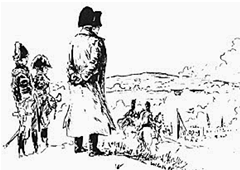 xxxxxAs we have seen, having outmanoeuvred the Austrians and soundly defeated them at the Battle of Ulm in October 1805, Napoleon made a triumphant entry into Vienna, the Austrian capital, in mid-
xxxxxAs we have seen, having outmanoeuvred the Austrians and soundly defeated them at the Battle of Ulm in October 1805, Napoleon made a triumphant entry into Vienna, the Austrian capital, in mid-
xxxxxNapoleon advanced his army of some 68,000 men as far as Brunn, and in December 1805 found himself facing an Austro-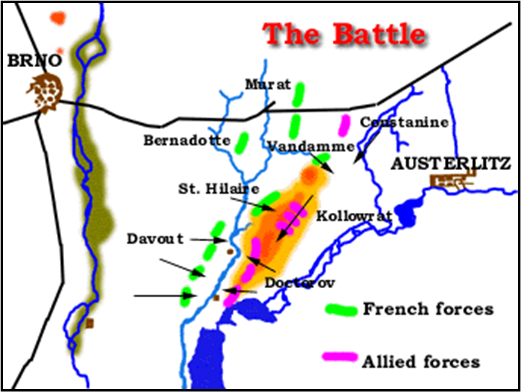 Russians advanced on his right flank (numbering about 40,000) and the Austrians on his left. Having prepared for these movements, both forces were intercepted and beaten back, and Napoleon then launched his main force, some 20,000 infantry, against the allies’ weakened centre on the Pratzen Plateau. After fierce fighting, the French captured the high ground and, reinforced by reserves, repulsed a number of attacks before breaking through the enemy’s lines and driving most of the Austrians and Russians into the small town of Austerlitz (now Slavkov in the Czech Republic). From here the coalition forces made their retreat, pounded by French artillery.
Russians advanced on his right flank (numbering about 40,000) and the Austrians on his left. Having prepared for these movements, both forces were intercepted and beaten back, and Napoleon then launched his main force, some 20,000 infantry, against the allies’ weakened centre on the Pratzen Plateau. After fierce fighting, the French captured the high ground and, reinforced by reserves, repulsed a number of attacks before breaking through the enemy’s lines and driving most of the Austrians and Russians into the small town of Austerlitz (now Slavkov in the Czech Republic). From here the coalition forces made their retreat, pounded by French artillery.
xxxxxThe Battle of Austerlitz (illustrated under Gérard below) was one of Napoleon’s greatest military engagements. Fought against a larger force, it inflicted heavy loses on the enemy (estimated at 15,000), captured some 11,000, and proved once again the French commander’s superior skill on the battlefield. Sometimes known as “The Battle of the Three Emperors” -
xxxxxIncidentally, War and Peace, the novel completed by the Russian writer Leo Tolstoy in 1869, gives an account of Napoleon’s victory at the Battle of Austerlitz in 1805, and of his invasion of Russia in 1812. Perhaps he can be forgiven for depicting Napoleon as a useless egomaniac!
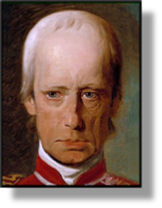
xxxxxFollowing their defeat at the Battles of Ulm and Austerlitz, Francis II of Austria (illustrated) was forced to accept the harsh terms imposed by the French at the Treaty of Pressburg (now Bratislava in Slovakia), held at the end of December 1805. The Austrians renounced all interest in Italy, giving over all their Venetian territory to Napoleon’s kingdom of Italy (including Venice, Istria and Dalmatia), whilst in central Europe, an area for so long under their sway, their power was substantially reduced. Napoleon’s protégés, Baden, Bavaria and Wurttemberg, having fought for the French, were released from all feudal ties associated with the defunct Holy Roman Empire, granted full independence, and ceded slices of Habsburg territory. In addition, Austria had to pay an indemnity of 40 million gold francs.
xxxxxIncidentally, by way of compensation, Napoleon allowed Austria to annex Salzburg (the birthplace of the composer Wolfgang Amadeus Mozart) and Berchtesgaden, where the German dictator Adolf Hitler was to build his mountain retreat, the “Eagle’s Nest”, in the 1930s. Mozart, born in 1756, was not, in fact, Austrian by birth. At that time Salzburg -
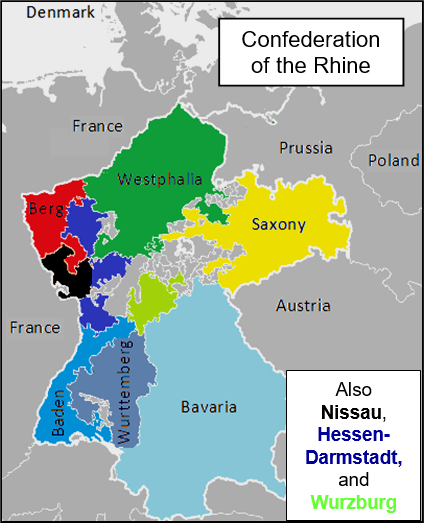 xxxxxFollowing the Treaty of Pressburg, the vacuum created by the collapse of the Holy Roman Empire was speedily filled by the Confederation of the Rhine. Engineered by the French in the summer of 1806, this comprised of all the minor states which had been dominated by the Habsburgs within the German Empire, including the enlarged kingdoms of Bavaria and Württemberg -
xxxxxFollowing the Treaty of Pressburg, the vacuum created by the collapse of the Holy Roman Empire was speedily filled by the Confederation of the Rhine. Engineered by the French in the summer of 1806, this comprised of all the minor states which had been dominated by the Habsburgs within the German Empire, including the enlarged kingdoms of Bavaria and Württemberg -
xxxxxAt the beginning of August 1806 the states within the union officially seceded from the Holy Roman Empire -
xxxxxAs for the Confederation, once formed, this sham of a union was presided over by Karl Theodor von Dalberg, archbishop of Mainz, and plans were made for the setting up of legislative bodies. At one time it was even suggested that a constitution be drawn up for this “new and improved” Germany. As was to be expected, the confederation collapsed with Napoleon’s downfall in 1813, but it did show that a form of union was possible and, in that respect, it contributed in some measure to the movement for German unification.
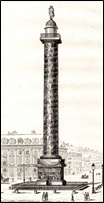 xxxxxIncidentally, the Vendôme Column in Paris, built by Napoleon to depict his victories over the Russians and Austrians, was completed in 1810. Modelled on Trajan’s Column in Rome, it was made of stone but was encased in bronze to provide a series of reliefs. The bronze for this work came from the thousand or more cannons captured at the Battle of Austerlitz and subsequently melted down. Erected in the Place Vendôme -
xxxxxIncidentally, the Vendôme Column in Paris, built by Napoleon to depict his victories over the Russians and Austrians, was completed in 1810. Modelled on Trajan’s Column in Rome, it was made of stone but was encased in bronze to provide a series of reliefs. The bronze for this work came from the thousand or more cannons captured at the Battle of Austerlitz and subsequently melted down. Erected in the Place Vendôme -
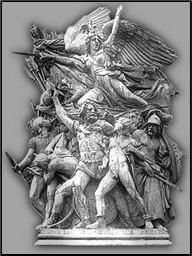 xxxxx…… Thexother great monument to Napoleon’s victorious military campaigns was the Arc de Triomphe, begun in 1806 but not finished until 1836. With a height of 164ft and a width of 148ft, it is the largest triumphal arch in the world. It was designed by the French architect Jean Chalgrin (1739-
xxxxx…… Thexother great monument to Napoleon’s victorious military campaigns was the Arc de Triomphe, begun in 1806 but not finished until 1836. With a height of 164ft and a width of 148ft, it is the largest triumphal arch in the world. It was designed by the French architect Jean Chalgrin (1739-
Including:
The Treaty of Pressburg,
The Confederation of the Rhine
and François Gérard

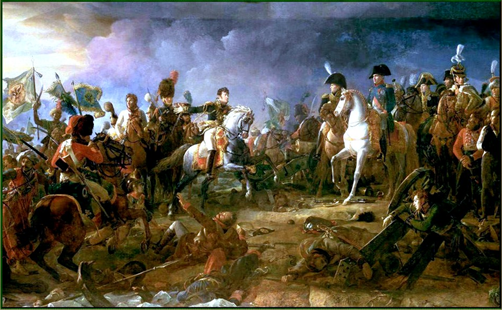 xxxxxThis painting of the Battle of Austerlitz was the work of the French neo-
xxxxxThis painting of the Battle of Austerlitz was the work of the French neo-
xxxxxThe favourite pupil of the French artist Jacques-
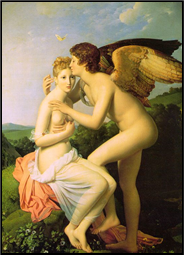
xxxxxGérard’s fame and fortune was assured in 1800 when Napoleon commissioned him for all his official portraits. From that time onwards he painted close on 300 portraits of well-
xxxxxPortraits shown below (left to right) are the French poet Alphonse de Lamartine, Madame de Récamier (the subject of David’s famous portrait of 1800), the mystic Saint Teresa of Avila, and the French artist Antoine-
xxxxxThe French neo-
G3c-



